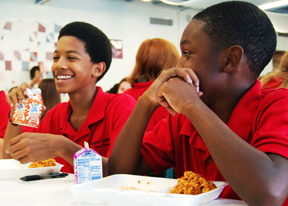Story By Chelsea Quackenbush
Photos By Rachel Scott
After Hurricane Katrina swamped his hometown, 15-year-old New Orleans native Killian “Bingo” Zacharias would soon find himself in a new state and a strange community – Waco. He would also find himself repeating his freshman year because his academic records had been destroyed by Katrina, along with everything else in his old neighborhood.
Officials at Midway High School determined that Bingo would be a freshman, since they had no record that he completed ninth grade. He was frustrated and unchallenged at Midway, he said. He hated having to retake Algebra 1 and English 1. Both his grades and his interest in academics were slipping.
Life was tough for the shy newcomer, soon gutted of self-esteem. At the end of the first year, Bingo’s future looked as dismal as the storm-tattered landscape he’d fled back home. He didn’t try, and he didn’t care. He had no goals.
Then he found Waco’s charter school, Rapoport Academy.
***
In 1995, Nancy Grayson was an angry woman — angry at the social injustice many children suffered in East Waco. Among the largely poor and minority students, only 30 percent were passing by third grade and only 10 percent were passing by fifth grade on the Texas Assessment of Knowledge and Skills. Better known as TAKS, this standardized test is used in primary and secondary schools to assess students’ knowledge of reading, writing, math, science and social studies.
“Enough,” Grayson said. “We can do better.”
At the time, Grayson held a doctorate in psychology and had been teaching since 1971, but she had no experience running a school. She was convinced, though, that she could do better than what she saw, that she could make a difference. The school she envisioned would make the students the priority, built on a foundation of six core values: respect, responsibility, curiosity, creativity, integrity and hard work. Everything thereafter would be trial and error.
After the State Board of Education issued the school a charter in 1998, Grayson spent years dedicated to grant writing. The school started with 16 children in the basement of Wesley United Methodist Church. The next year it grew to 74 students, requiring a move to a one-story building that housed the pre-kindergarten through second-grade students. Rapoport Academy today boasts 380 students and 60 full-time teachers in three schools in Waco.
The definition of charter schools has often perplexed those not involved. It is not a private school; it is not an alternative or remedial school for “troubled” children. Grayson created Rapoport as a public educational choice for children who, for whatever reason, were dissatisfied with public school but don’t have the resources to attend private school. Rapoport strives to embrace the most innovative and effective educational model.
The school does not charge tuition, another common misconception. While Waco ISD schools are funded by property taxes from each district, a charter school is funded by the state of Texas. Rapoport Academy’s budget is $3 million a year, provided largely by two national private foundations. State funding for Rapoport has amounted to 65 percent of what Texas provides public schools, Rapoport officials said.
Even the name has misled people. Many believe that the school is funded by the Bernard and Audre Rapoport Foundation of Waco, but it’s not.
“We named the school ‘Rapoport’ to honor Mr. Rapoport,” Grayson said of the longtime Waco businessman and philanthropist. “He once said ‘Education is the great equalizer.’ We want to cement that philosophy.”
***
Bingo Zacharias felt like a failure. But despite his uninspired academic performance at Midway High, he knew he could do better. Eventually he heard about Rapoport Academy and took the entrance test, even though it would mean that because of its accelerated curriculum, he would have to repeat his freshman year once again.
“There is nothing wrong with Midway,” Bingo said. “It’s a great school. My brother goes there; it works for him. Rapoport wouldn’t work for him, but it works for me.”
At 19, Bingo will soon have six years of high school behind him. When he graduates in May 2010, he will also have finished two years of college hours at Texas State Technical College. Awaiting him already are academic scholarships from across the nation. Rapoport has allowed him to accomplish above and beyond anything he imagined.
“I was always a shy kid who tended to sit on the sidelines and watch others,” he said. “Here at Rapoport, I am forced into the spotlight because it is so small, and there is so much individual attention. But it has given me self-confidence and made me realize my potential.”
Although not involved in one of five varsity sports offered at Rapoport, Bingo is a member of the choir and an officer on the Community Council, an honor court designed to hold students accountable to the school’s core values. Seniors, selected by their teachers and their peers, must show high integrity to be considered for the position. He also works at a local Pizza Hut restaurant about 25 hours a week, while balancing a full course load at TSTC. Bingo is at the top of the first senior class to graduate from Rapoport’s Myer High School.
***
Taking classes at TSTC is a unique opportunity for Rapoport students. Starting as early as ninth grade, students can eventually earn up to 72 hours of college credit. In addition, the Rapoport curriculum is based heavily on preparing students for college and the professional world.
“If you ask our preschoolers, they can tell you what year they’ll begin college,” Grayson said.
They use the public school system’s curriculum, but with additional content. The teachers are encouraged to be more creative, and don’t have to limit learning to the textbooks. They believe they have set the bar higher than most schools, even for those performing above the curve.
“We are constantly saying to them, ‘You’re doing well, but how can you do better?’ Because in this world, you can’t be good. You have to be better,” Grayson said. “In a job interview, you can’t be at the same level as all the other applicants; you won’t get the job. We give them the tools to be successful.”
Grayson believes the non-traditional structure is what allows students to excel. Over the summer, the physical education curriculum was redesigned to include a math and science aspect. Instead of simply running laps around the “track” (circular driveway of the campus), students are taught what is happening to their bodies as they run. They learn about the impact, their body’s chemistry, and even diseases that they are fighting off through exercise. A physical education teacher enters Grayson’s office and asks if she can get a map of the US hung up by Friday for the students. It will be there Thursday, Grayson assures. She explains that the map is for students to “run across America — they are actually tracking their distance as they run and mapping it. They are not only learning PE, but they are learning about measurement, geography, climate and topography.” This is only one example of their cross-content curriculum. There is no pigeonholing, because in the real world, everything is related. Their music program integrates math by tracking patterns and note counting. Their English class might integrate math by using it to divide into smaller groups.
***
Middle-school history and geography teacher Jennifer Hadley admires the school’s ability to teach professional and social skills, along with its rigorous academic curriculum.
“I can’t say enough positive things about the school,” she said. “There is respect between students and teachers.”
Hadley explained that students are taught to stand up when speaking in class, to make them more comfortable speaking in front of a group. They are taught to make eye contact and to shake a person’s hand upon first meeting. They look at each other when they talk. They are taught to challenge one another, challenge what they think is wrong. They are not afraid to speak up. They are taught that life isn’t fair, and it is not enough to settle for status quo; they need to be smarter, better and work harder to be successful.
“It’s great that I can expect a lot from students, which is what you think of when you envision being a teacher,” Hadley said.
She applauds the nurturing support of the teaching staff, the small classes where she can interact personally with students and the overall high expectations of the school.
Hadley believes the high expectations and the school’s “no excuses” mentality changes everything not only for the student but also for the faculty and staff. “I have the utmost respect for the administration. They walk the fine line between support and control and are able to balance it every day.”
This is Hadley’s first year as a teacher at Rapoport. Previously she taught at a Waco ISD school but decided to apply for a position after enrolling her daughter this past summer. The rewards go beyond education. For Hadley and her daughter, Lenore Wright, it’s personal.
“I have seen such a change in Len,” Hadley said. “It used to be a struggle to get her to get up for school, to get her to do her homework. After her first week here, it was like, ‘Where is my child and where did she go?’ She has done a complete 180. She is motivated to come to school; she’s excited and happy. She has double the amount of work, but she has a desire to do it and to be here. I am thrilled.”
Coming from China Springs and six months of home-schooling, the transition to Rapoport was easy for Lenore, a 15-year-old sophomore. Like Bingo, she didn’t feel challenged at her previous school. She didn’t feel like she fit in.
“Obviously you can tell I’m different,” she said, referring to her black fishnet stockings, plaid skirt and layers of silver chains that adorn her neck. “At Rapoport, no one cares because everyone here is different. You don’t feel alone because you aren’t judged. Everyone just gets along.
“At my old school, I was always upset. I had no friends and no one cared. I felt very alone,” she said as she gently tucked her shoulder-length light brown hair behind her ears. But within the first week of school, Lenore beamed, she’d already made five new friends.
The social aspect is not the only reason Lenore is thankful for Rapoport. Even though she won’t start classes at TSTC until next year, she still feels like her opportunities are greater. She thrives from the one-on-one time with teachers, as well as the everyday challenge to work harder. Lenore admits it’s more work than she’s used to, but she likes being pushed. She knows that when she isn’t doing well on something, there is always extra help. She feels encouraged by her teachers, even when she makes mistakes.
“We learn from our mistakes in a positive way, so we don’t repeat them the next time around,” she explained. “I can look at something and feel good because I got this right, but it makes it easier to accept when I don’t do well on something else.”
***
Although Grayson is the founder and superintendent of Rapoport, she refuses to take sole credit for its successes. Donna Williams, front desk secretary and National School Lunch Program director, articulates the sentiment toward Grayson held by the community.
“She is always in overalls,” Williams said. “If she has a really important meeting, she’ll change into other slacks, but then put the overalls back on once the meeting is over. You’ll often times find her outside pulling weeds in the yard or whatever it take to keep the school going — she is one awesome lady.”
Rapoport’s innovative educational model has been recognized state- and nationwide. It received an $800,000 grant to disseminate its best practices among other charter and traditional schools. In fall 2008, Rapoport was awarded the prestigious T-STEM and ECHS designations by the Bill and Melinda Gates Foundation, as well as the Michael and Susan Dell Foundation through the Communities Foundation of Texas. These designations highlight the school’s focus on science, technology, engineering, and math, as well as its early-college high school option.
Dean of Students Rick Allen realizes the challenges that the lack of funding poses.
“We don’t spend money on ‘stuff,’ we spend it on students,” he explains.
This is evident after a quick survey of the campus and the interior of the buildings. Before it’s opening, the building for the high school was buried under trees and bushes. The students cleaned it out, swept and mopped the hallways repeatedly, until the school was renovated and ready for use. An entity in town donated old lockers for the students to use – and another company gave the lockers a new look with fresh paint. Photos documenting the revival are displayed in the school’s hallways.
The six core values of Rapoport are prominently displayed throughout the schools. Master teacher Heather Franks said she believes the core values are the soul of the school.
“We all have a shared vision,” she said. “Everyone wants to work together for the sense of community.”
***
As Bingo Zacharias looks to the future, he says he’ll never leave Rapoport behind as a distant memory. Aspiring to study either mathematics or biomedical engineering, he now has a greater goal than “not being in poverty.” He wants to be a leader in his field. He wants to have enough for himself and more, in order to give back to others like him in his adopted hometown.
“I see the vision the school has of not only helping other students and the school but the surrounding community,” he said. “I see where it’s going and I want to be a part of it. The school has done so much for their students, families and community that my first priority is to come back and help the school.”
Top universities across the country have approached him for admission in fall 2010, including Tulane University in New Orleans, Cornell University in New York and the Massachusetts Institute of Technology.
Four years ago, Bingo thought all was lost. He was uprooted from his home and thrust into a strange environment, set back by a lack of academic records and dispirited by having to repeat his freshman year. But his search for an education that would not only challenge but prepare him to make a difference in life took a dramatic upswing when he discovered Rapoport. Now, with three freshman years behind him, he has found his future.




